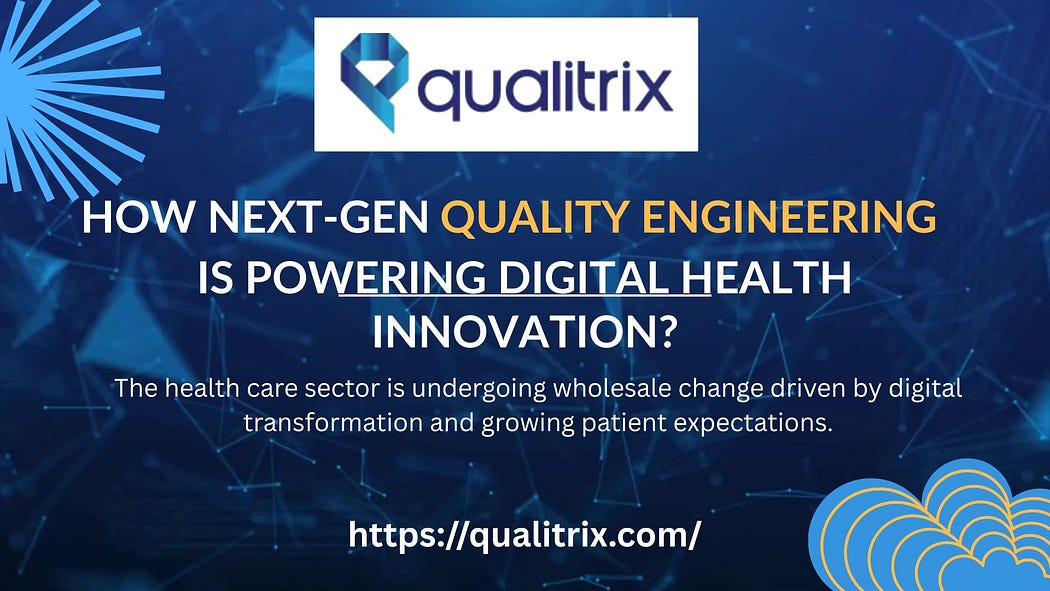How Next-Gen Quality Engineering Is Powering Digital Health Innovation?
 SoftwareTestinginIndia
SoftwareTestinginIndia
The health care sector is in the midst of a large-scale change, which is being brought about by digital transformation, growing patient expectations, and the push for data-driven care. From telemedicine and wearables to AI-based diagnostics and electronic health records (EHR), we are seeing that the digital health trend is in fact changing how care is provided and experienced.
Also, we see that for the success of these new innovations in the digital health space, we must have a different approach to quality, which looks beyond what we have used in the past, that is, traditional testing. That is the stage at which Next Generation Quality Engineering (QE) comes in.
Digital Health’s Evolution and also it’s Challenges.
Digital health solutions are in a high-risk environment. They work with very private patient information, real-time analytics, and smooth integration of hardware, software, and cloud infrastructure. A tiny bug in a health app or a delay in a wearable’s data sync could put clinical results and patient safety at risk. Also, health care apps must meet very strict regulatory requirements like HIPAA, FDA, and HL7.
These issues put forth the case for moving from reactive testing to proactive quality engineering, which in turn sees quality as a part of every product lifecycle stage.
What Is Next-Gen Quality Engineering?
Next generation Quality Engineering is a strategy that we put forward, which includes automation, AI/ML technologies, continuous testing, and in-depth domain knowledge in order to achieve the best-in-class software quality. Also, in contrast to the isolated practice of traditional QA, which often occurs at the end of the development cycle, we have a very integrated, intelligent, and agile approach in Quality Engineering.
For digital health innovators, we see faster time to market, better application resilience, and more patient trust.
Key Components Fueling Digital Health Innovation
- AI-Powered Test Automation
AI and machine learning are redefining test case generation, test data management, and defect prediction in digital health. In these tech-enabled health care systems, we see that which areas have high risk identified, which test scenarios to run first are determined, and flaky scripts are corrected in real time, which in turn enables real-time validation of complex processes like appointment setting, remote diagnosis, and claims processing.
- Continuous Testing in CI/CD Pipelines
Continuous integration and delivery (CI/CD) is what we use for very fast releases and updates. In the field of next-generation QE, we have implemented continuous testing across devices, operating systems, and user conditions, which in turn guarantees that each release is secure, compliant, and performant.
- Patient-Centric UX Testing
Quality engineering is a much larger field than just functionality. We see in it the element of user experience, which in turn includes accessibility, usability, and intuitive design, very important elements for elderly patients, different abilities, or tech-insensitive consumers who use digital health tools.
- Data Integrity and Compliance Assurance
Digital health technologies work with private health data, which we must keep accurate, consistent, and secure across systems. QE teams put in place robust validation procedures, encryption testing, and audit trails to meet healthcare regulations and standards.
- Performance and Scalability Testing
Applications of teleconsultation platforms and digital triage tools must be able to handle large surges in user traffic without breakdown. Performance engineering in this case is what enables these systems to scale very well and respond in real time at peak load.
Quality Health Care Delivery through Engineering Solutions.
A large health tech company that developed a telehealth platform, which, early on in the product development, incorporated next-gen QE practices. Through AI-based automation and continuous testing, they were able to reduce their release cycle from 30 days to 10. Also of great importance was that they saw a 70% reduction in defect leakage, which in turn provided our patients with a very consistent and secure experience during virtual visits. This not only improved adoption but also resulted in quick regulatory approvals.
Quality in Health Care Business Case.
In digital health, quality is not just a technical metric; it is a business success driver. Effective QE practices, which in turn produce:
Quicker time to market for new features and apps.
Improved patient safety and satisfaction.
Higher audit and certification preparedness.
Reduced operations cost and post-release bug fixes.
Conclusion
As the digital health transformation is in full speed, we see that which is strong, flexible, and intelligent quality engineering is a must. Next-gen QE enables health care innovators to put out safe, reliable, and user-centered digital solutions at a large scale. It is the element that connects technology and trust, which in turn fuels innovation that transforms lives.
You can find more thoughtful articles on similar topics in the Qualitrix blog section.
Subscribe to my newsletter
Read articles from SoftwareTestinginIndia directly inside your inbox. Subscribe to the newsletter, and don't miss out.
Written by

SoftwareTestinginIndia
SoftwareTestinginIndia
At Qualitrix, we’ve helped global enterprises and startups enhance software quality, reduce tech debt, and accelerate digital transformation with AI-driven automation, crowdtesting, and expert-led assurance. Let’s build a future of flawless digital experiences together.